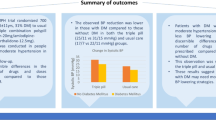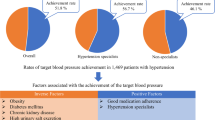Abstract
Based on outcome trials, guidelines for hypertension management recommend lower blood pressure (BP) goals using an individualized treatment strategy (IND) and referral to a specialist of patients uncontrolled after 6 months of treatment. This study aimed to evaluate the performance of General Practitioners (GPs) in reaching the recommended BP goals using the IND, or a stepwise treatment strategy (STEP) as used in the outcome trials. Trained GPs were randomized to reach the BP goals within 6 months using the IND or a STEP strategy in untreated or treated uncontrolled hypertensives. In all, 24 GPs recruited 528 patients of whom 443 were analysed (mean age 65±9 years, 42% men, 70% treated, STEP/IND 12/12 GPs, 231/211 patients). After 6 months, 83% of the patients had reached the diastolic BP goal, whereas only 51% the systolic (P<0.0001 for difference). Factors associated with uncontrolled systolic BP were diabetes, age >60 years and triple antihypertensive therapy at baseline. A faster BP reduction was achieved during the first 3 months using the STEP strategy, but at the cost of using more drugs (combination therapy in 68/59% for STEP/IND, P=0.06). At 6 months similar rates of control were achieved with the two strategies. In conclusion, in primary care the diastolic BP goal can be reached within 6 months in the majority of patients, whereas systolic BP remains uncontrolled in 50% of the cases. The IND should be the recommended treatment strategy, but further investigation is required on the reasons for treatment failure and the optimal strategy for its improvement.
This is a preview of subscription content, access via your institution
Access options
Subscribe to this journal
Receive 12 digital issues and online access to articles
$119.00 per year
only $9.92 per issue
Buy this article
- Purchase on Springer Link
- Instant access to full article PDF
Prices may be subject to local taxes which are calculated during checkout



Similar content being viewed by others
References
Joint National Committee on Detection, Evaluation and Treatment of High Blood Pressure. The sixth report of the Joint National Committee on the detection, evaluation and treatment of high blood pressure (JNC VI). Arch Intern Med 1997; 24: 2413–2446.
Marques-Vidal P, Tuomilehto J . Hypertension awareness, treatment and control in the community: is the “rule of halves” still valid? J Hum Hypertens 1997; 11: 213–223.
Burt VL et al. Prevalence of hypertension in the US adult population. Results from the third National Health and Nutrition Examination Survey 1988–1991. Hypertension 1995; 25: 305–313.
Stergiou GS, Thomopoulou GC, Skeva II, Mountokalakis TD . Prevalence, awareness, treatment and control of hypertension in Greece: The Didima study. Am J Hypertens 1999; 12: 959–965.
Hansson L et al. Effects of intensive blood-pressure lowering and low-dose aspirin in patients with hypertension: principal results of the Hypertension Optimal Treatment (HOT) randomized trial. Lancet 1998; 351: 1755–1762.
UK Prospective Diabetes Study Group. Tight blood pressure control and risk of macrovascular and microvascular complications in type 2 diabetes: UKPDS 38. Br Med J 1998; 317: 703–713.
1999 World Health Organization—International Society of Hypertension guidelines for the management of hypertension. J Hypertens 1999; 17: 151–183.
Wester PO, Bjorck JE . Effect of angiotensin-converting-enzyme inhibition compared with conventional therapy on cardiovascular morbidity and mortality in hypertension: the Captopril Prevention Project (CAPPP) randomized trial. Lancet 1999; 353: 611–616.
Hansson L et al. Randomized trial of old and new antihypertensive drugs in elderly patients: cardiovascular mortality and morbidity the Swedish Trial in Old Patients with Hypertension-2 study. Lancet 1999; 354: 1751–1756.
The Heart Outcomes Prevention Evaluation Study (HOPE) Investigators. Effects of an angiotensin-converting-enzyme inhibitor, ramipril, on cardiovascular events in high-risk patients. N Engl J Med 2000; 342: 145–153.
Brown MJ et al. Influence of diabetes and type of hypertension on response to antihypertensive treatment. Hypertension 2000; 35: 1038–1042.
Kjeldsen SE et al. Lowering of blood pressure and predictors of response in patients with left ventricular hypertrophy: the LIFE study. Losartan Intervention For Endpoint. Am J Hypertens 2000; 13: 899–906.
Mann J, Julius S . The Valsartan Antihypertensive Long-term Use Evaluation (VALUE) trial of cardiovascular events in hypertension. Rationale and design. Blood Press 1998; 7: 176–183.
Ramsay LE et al. Guidelines for management of hypertension: report of the third working party of the British Hypertension Society. J Hum Hypertens 1999; 13: 569–592.
Feldman RD et al. Task Force for the Development of the 1999 Canadian Recommendations for the Management of Hypertension. CMAJ 1999; 161:S1–S17.
O'Brien E, Mee F, Atkins N, Thomas M . Evaluation of three devices for self-measurement of blood pressure according to the revised British Hypertension Society Protocol: the Omron HEM-705CP, Philips HP5332 and Nissei DS-175. Blood Press Monit 1996; 1: 55–61.
Beevers DG . Blood pressure that falls on rechecking. Br Med J 1982; 284: 71–72.
Pickering TG et al. How common is white coat hypertension. JAMA 1988; 259: 225–228.
MacMahon S et al. Blood pressure, stroke, and coronary heart disease. Part 1, prolonged differences in blood pressure: prospective observational studies corrected for the regression dilution bias. Lancet 1990; 335: 765–774.
Julius S . Therapeutic control of systolic blood pressure: what do trials teach us. Seventh International Forum for the Evaluation of Cardiovascular Care (IFECC-VI). Monte-Carlo 2002. Abstract book, 47 pp.
Berlowitz DR et al. Inadequate management of blood pressure in a hypertensive population. N Engl J Med 1998; 339: 1957–1963.
Fagard RH, Van Den Enden M, Leeman M, Warling X . Survey on treatment of hypertension and implementation of World Health Organization/International Society of Hypertension risk stratification in primary care in Belgium. J Hypertens 2002; 20: 1297–1302.
Oliveria SA et al. Physician-related barriers to the effective management of uncontrolled hypertension. Arch Intern Med 2002; 162: 413–420.
Izzo JL, Levy D, Black HR . Importance of systolic blood pressure in older Americans. Hypertension 2000; 35: 1021–1024.
Strategies for improving control of systolic blood pressure. Continuing medical education Web-cast series American Society of Hypertension. May 2002–May 2003. www.ash-us.org.
Acknowledgements
We thank Dr Solon Solomon and Dr Irini Skeva for helping in setting the study database, Bristol Myers Squibb Greece for partial support of the study and G Leoussis SA, Athens, Greece for providing 35 Omron HEM-705CP devices and for technical support throughout the study.
Author information
Authors and Affiliations
Corresponding author
Appendix
Appendix
The ABC-GP Study Group
Christos Papathanakis (Health Center/National Health System [HC/NHS] of Orestiada, Evros); Dimitrios Petridis (HC/NHS of Echinos, Xanthi); Dimitrios Hellinas (HC/NHS of Prinos, Island of Thassos); Filitsa Piperkou (HC/NHS of Almiros, Magnessia); Ioannis Monedas (HC/NHS of Lefkimi, Island of Corfu); Alexandros Vassibossis (HC/NHS of Vlachioti, Laconia); Fani Sarigianni (HC/NHS of Velestino, Magnessia); Dimitrios Giannopoulos (HC/NHS of Agiassos, Island of Lesvos); Michael Flatsoussis (HC/NHS of Pirgi, Island of Chios); Dimitrios Kalabalikis (HC/NHS of Amphilochia, Aitoloakarnania); Theodoros Pavlidis (Social Insurance Fund, Policliniki, Stavroupolis, Kavala); Ioannis Abouzolof (General Practice of Velo, Corinthia); Antonios Batikas (HC/NHS of Perama, Rethymno, Island of Crete); Dimitra Karathanassi (HC/NHS of Varda, Achaia); Andreas Chatzialexandrou (HC/NHS of Kato Achaia, Achaia); Dimitrios Michalis (HC/NHS of Aliartos, Boeotia); Nikolaos Razis (HC/NHS of Calavrita, Achaia); Chariklia Androutsopoulou (HC/NHS of Iasmos, Rhodopi); Ioannis Dacoronias (HC/NHS of Karystos, Island of Euboea); Pavlos Nastas (HC/NHS of Thessprotiko, Thessprotia); Marios Chatziarsenis (HC/NHS of Neapolis, Island of Crete); Thomas Agelopoulos (HC/NHS of Prinos, Island of Thassos); Maria Panagopoulou (HC/NHS of Neapolis, Island of Crete); Panagiotis Raftopoulos (HC/NHS of Iasmos, Rhodopi).
Rights and permissions
About this article
Cite this article
Stergiou, G., Karotsis, A., Symeonidis, A. et al. Aggressive blood pressure control in general practice (ABC-GP) study: can the new targets be reached?. J Hum Hypertens 17, 767–773 (2003). https://doi.org/10.1038/sj.jhh.1001610
Received:
Revised:
Accepted:
Published:
Issue Date:
DOI: https://doi.org/10.1038/sj.jhh.1001610
Keywords
This article is cited by
-
Achievement of individualized treatment targets in patients with comorbid type-2 diabetes and hypertension: 6 months results of the DIALOGUE registry
BMC Endocrine Disorders (2015)
-
Combination pharmacotherapy in hypertension
International Urology and Nephrology (2007)
-
Beyond the Evidence of the New Hypertension Guidelines. Blood pressure measurement – is it good enough for accurate diagnosis of hypertension? Time might be in, for a paradigm shift (I)
Current Controlled Trials in Cardiovascular Medicine (2005)
-
Angiotensin receptor blockade in the challenging era of systolic hypertension
Journal of Human Hypertension (2004)



